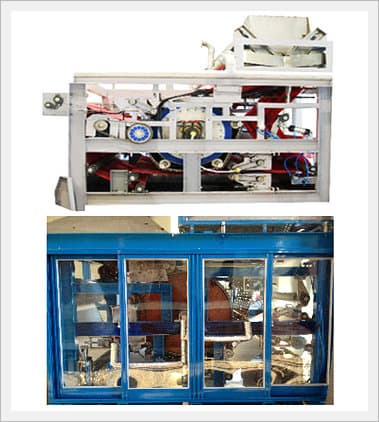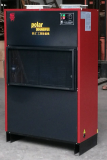Electro-osmosis Dehydrating
Negotiable Min Order Quantity Unit
- Required Quantity
-
- Place of Origin
- Payment Terms
- Negotiable
- Production method
- Negotiable
- Shipping / Lead Time
- Negotiable / Negotiable
- Keyword
- Category
- Other General Industrial Equipment
Apply a video call to the Supplier
E&D Global
- Country / Year Established
-
 South Korea
/
South Korea
/
- Business type
- Others
- Verified Certificate
-
11

| Product name | Electro-osmosis Dehydrating | Certification | - |
|---|---|---|---|
| Category | Other General Industrial Equipment | Ingredients | - |
| Keyword | - | Unit Size | - |
| Brand name | - | Unit Weigh | - |
| origin | Stock | - | |
| Supply type | - | HS code | - |
Product Information
Electro-osmosis Dehydrating Technology
Introduction
Electro-osmosis dehydrating is technology which reduces the percentage of water content down to 60 percent using mechanical dehydrating in the principle of destructing protoplasm of microorganism in sludge by utilizing electro-osmosis principle and the Brawnian motion, the inherency of electricity.
The electro-osmosis principle that we use is the nature which electrons take water molecules(xH2O) while moving from positive pole to negative pole when current flows into suspended material where water and solids are mixing. The Brownian motion which is incidentally used is a phenomenon that when current flows in suspended mixture surrounded by membrane, same kinds of ions actively move for molecular combination, which generate frictional heat and the volume in the membrane is expanded and the thickness of membrane becomes thin, so the membrane is torn just by slight external pressure.
For an effective dehydrating of sludge, cell membrane of sludge must be broken to eliminate water in the cell. In general, the percentage of water content is limited to about 80 percent because the existing mechanical dehydrating method is hard to deliver force to each and every cell. However, our technology of electro-osmosis dehydrating can dehydrate even bond water which is hard to be dehydrated mechanically and achieve 60 percent of water content.
Principle of Electro-osmosis Dehydrating

Process to Destruct Cells by Electric Actions


Water Distribution in Sludge and Characteristics

|
Division
|
Characteristics
|
||
|
External Water
|
Free water
|
.Water attached to sludge particles .Easy to eliminate by gravitational sedimentation |
Easy to dehydrate |
|
Interstitial water
|
.Water found in-between floc of sludge and moving with floc .Also called floc water .Can be eliminated by mechanical dehydrating |
||
|
Internal Water
|
Surface water
|
.Water attached to sludge particles .Also called capillary water .Can be eliminated when cell is destructed and compressed |
Difficult to dehydrate |
|
Bound water
|
.Water chemically combined with sludge particles .Hard to eliminate by mechaniccal dehydrating |
||
| * Unlike the existing technology, a physical crimp-type dehydrating method, our technology of electro-osmosis dehydrating destructs cell itself by electric actions and can eliminate free water and interstitial water as well as surface water and bond water which have been hard to eliminate by the existing technologies. | |||
Why it is hard to dehydrate sludge
Sludge is residue discharged from sewage and waste water disposal process. Solid matter is mainly comprised of living or dead body lumps of microorganism. Sludge is degenerated into substance difficult to treat because of high-molecular cohesive agents, chemicals input to separate water and solid matter at the final step of disposing sewage and waste water.
Disposal Process

Strong Points of Electro-osmosis Dehydrating
|
Classification
|
E&D technology
|
Existing Technology
|
|||
|
Dehydrating
|
Electrolysis
|
Filter Press
|
Decanter
|
Belt Press
|
Vacuum Dehydrator
|
|
Applied principles
|
Electro-osmosis
|
Sludge supply pressure
|
Centrifugal force
|
Shear force, follicle compressing force
|
Vacuum filtration
|
|
Chemical in use
|
N/A
|
Polymeric cohesive agents
|
Polymeric cohesive agents
|
Polymeric cohesive agents
|
Polymeric cohesive agents
|
|
Water content after dehydrating
|
less than 65%
|
80~70%
|
85~70%
|
85~70%
|
85~70%
|
|
Operation expense
|
Electricity cost
|
Electricity cost added to high-pressure dehydrating
|
Low electric consumption
|
Electricity cost added to high-pressure dehydrating
|
High energy consumption
|
|
Pressure in use
|
Simple compression other than power supply
|
15kg/cm2
|
1,500~3,000G
|
10~20kg/m2/hr
|
10~25kg/m2/hr
|
|
Additional facilities
|
Steam eliminating facilities
|
Reaction facilities
Chemicals facilities Cleaning facilities |
Cleaning facilities
Soundproofing Dedust facilities |
Reaction facilities
Chemicals facilities |
Agitator equipment
Cleaning equipment Conveyor to discharge dehydrated cake |
|
Sludge supply
|
Continuous
|
Intermittent
|
Continuous
|
Continuous
|
Continuous
|
|
Applicability for change of characteristics of sludge
|
Good
|
Good
|
Good
|
Good
|
Good
|
|
Others
|
Disposing efficiency varies depending upon power supply
|
Difficult to work continuously due to batch-time operation
|
Lower recovery of solids, problems by high-speed revolution
|
Input of chemicals required
|
Odor occurs; lots of additional facilities
|
- Superior efficiency and economic feasibility to DC mode
- Cost to disposal of sludge on commission, facility expense and operation cost reduced
- Solves previous questions required to recycle sludge
- Preprocess technology can be applied to any method for an overland disposal of sludge
- Compact structure
Introduction of Products
EDG-S Series is the high-efficiency secondary dehydrator which can be installed at the read end of the existing primary dehydrator (belt press, decanter, etc.) and reduce the water content in sludge from 85 to 60percent using the electro-osmosis dehydrating principle.
|
EDG-S100
(Electro-osmosis Dehydrator by Global) |
EDG-S200
(Electro-osmosis Dehydrator by Global) |
 |
 |
|
Specification
|
EDG-S Series(water content 85%→60%)
(Electro-osmosis Dehydrator by Global) |
||
|
EDG-S100
|
EDG-S200
|
||
|
Belt Wide(mm)
|
1000
|
2000
|
|
|
Power consumption(kw)
|
70
|
130
|
|
|
Capacity(ton/hr)
|
0.3~0.4
|
0.6~0.75
|
|
|
Weight(ton)
|
4
|
6
|
|
|
Size
|
L(mm)
|
3200
|
3200
|
|
W(mm)
|
1500
|
2400
|
|
|
H(mm)
|
3200
|
3200
|
|
Equipment configuration

 |
 |
|
Electro-osmosis Dehydrating
Manufacturing Process Chart |
Electro-osmosis Dehydrating
Manufacturing Process Chart |
 |
 |
|
Electro-osmosis Dehydrating
Manufacturing Process Chart |
Electro-osmosis Dehydrating
Manufacturing Process Chart |
 |
 |
|
Installation Scene
|
Installation Scene
|
 |
 |
|
Electro-osmosis dehydrator Drive
|
Electro-osmosis dehydrator Drive
|
 |
 |
|
Before dehydrating water content - 83.13%
|
After dehydrating water content - 55.52%
|
B2B Trade
| Price (FOB) | Negotiable | transportation | - |
|---|---|---|---|
| MOQ | Negotiable | Leadtime | Negotiable |
| Payment Options | Negotiable | Shipping time | Negotiable |
- President
- Kwangsun Park
- Address
- 5F Shinhan building, 1294-18 Chipyeong-dong, Seo-gu, Gwangju, Korea
- Product Category
- Waste Management
- No. of Total Employees
- 1-50
- Company introduction
-
E&D Global was founded in 2012 as a global environmental company under the banner of green growth, the fundamental topic for human life. We have developed and completed new technologies for sludge reduction and succeeded in commercialization through our endless technical development and intense field experiences. Everyday we dump more than 10,000ton of sludge at sea, which causes marine environment pollutions that is on the rise as a serious problem at government level. Therefore, the government has prohibited a dumping of sludge at sea since 2012 and each of the local governments are considering alternatives for overland disposal of sludge. E&D Global has succeeded in solving all of these problems by a long technical development and great expense. 'Electro-osmosis Dehydrating' and 'Low-temperature Ventilation and Drying', both technologies completed by us, are the green original technology true to the name and will provide the best value. E&D Global promises to go with you as a global leading company for environment through commercialization of sludge disposal. Thank you.
- Main Product








































,_Smartphone_dryer,_heating_mobile_2.jpg)

